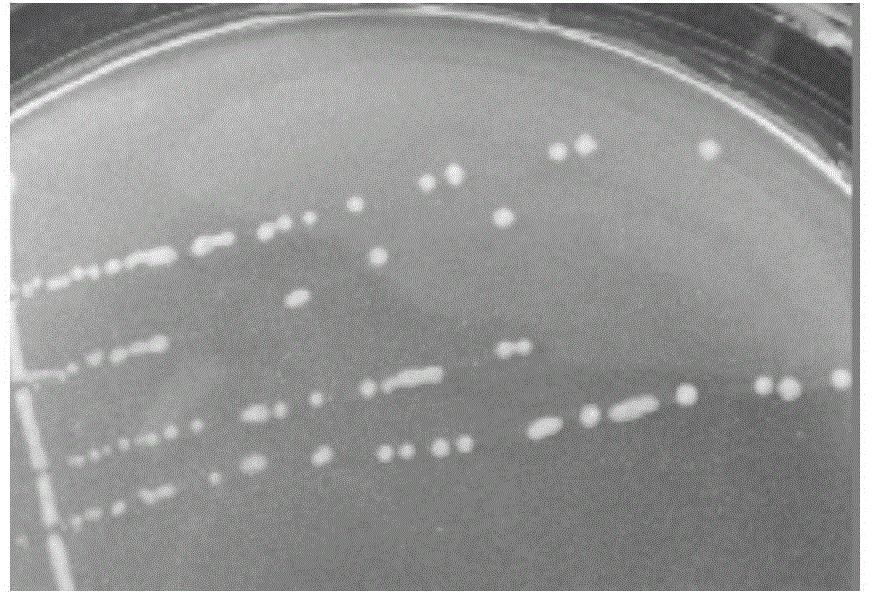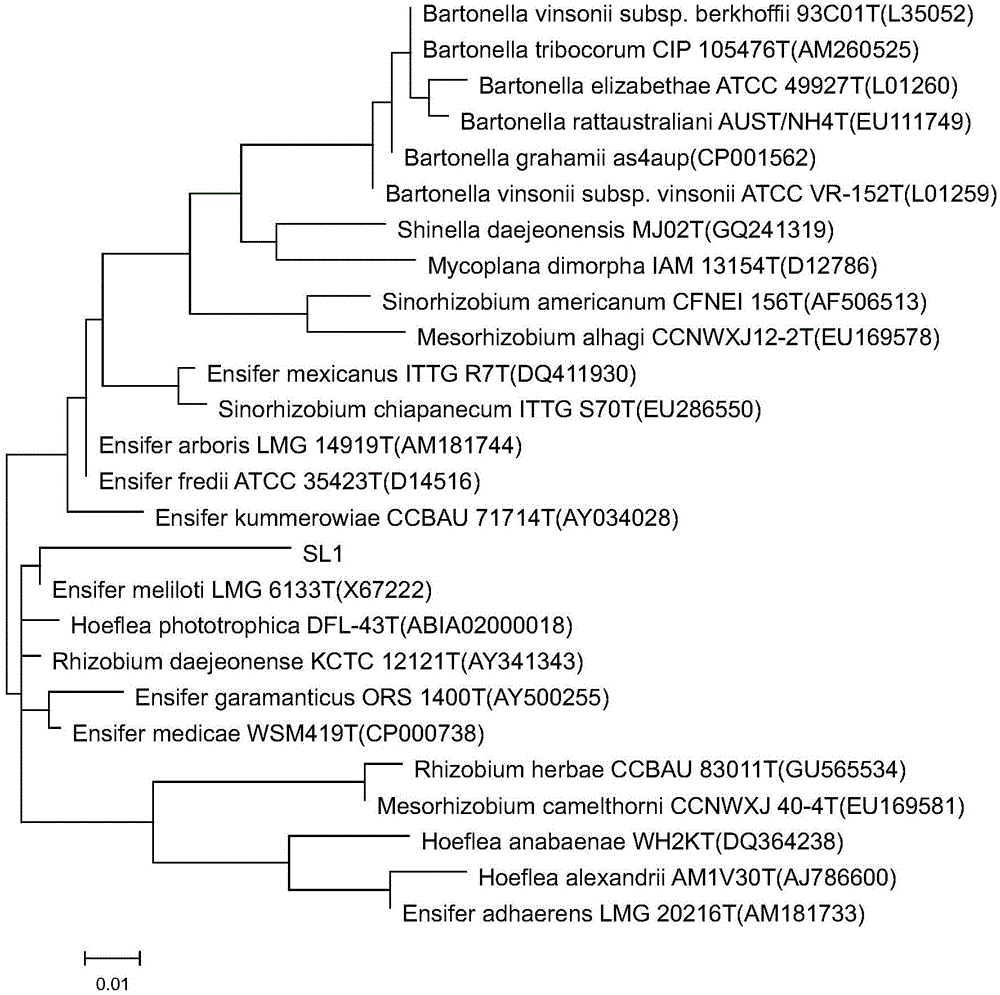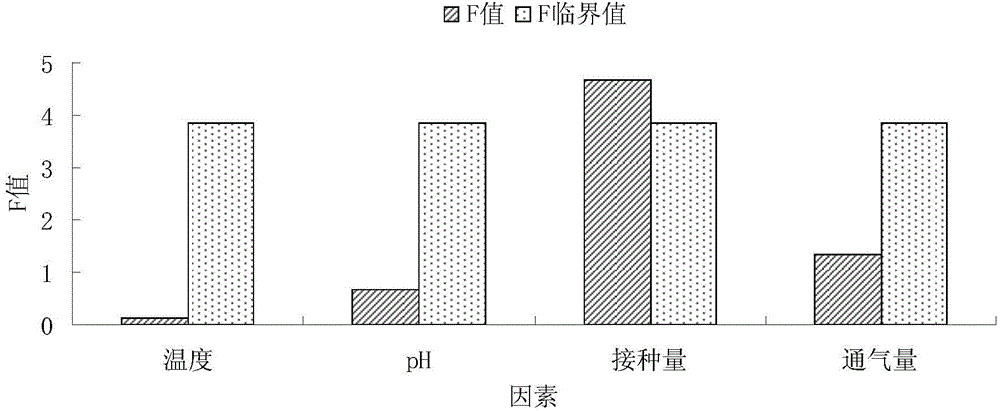Rhizobium capable of degrading polychlorinated biphenyl and application thereof
A technology of polychlorinated biphenyls and trichlorobiphenyls, applied in the field of microorganisms
- Summary
- Abstract
- Description
- Claims
- Application Information
AI Technical Summary
Problems solved by technology
Method used
Image
Examples
Embodiment 1
[0022] Example 1 Screening and identification of polychlorinated biphenyl degrading rhizobia
[0023] Medium preparation:
[0024] Modified basal salt medium (degradation medium): KH 2 PO 4 3.7g, K 2 HPO 4 ·3H 2 O5.2g, NH 4 Cl1.0g, Na 2 SO 4 1.0g, MgSO 4 ·7H 2 O0.2g, trace metal salt solution 1mL, add water to 1000mL, pH7.0~7.5. Add the acetone solution of PCB28 (2,4,4'-TCB) to make the concentration reach 1mg / L, as the only carbon source, and expose it until the acetone volatilizes for use. Add 18g / L agar to the solid medium.
[0025] Trace metal salt solution (1000mL deionized water): FeCl 2 4H 2 O0.3g, CoCl 2 ·6H 2 O0.038g, MnCl 2 4H 2 O0.02g, ZnCl 2 0.014g, H 3 BO 3 0.0124g, Na 2 MoO 4 2H 2 O0.04g, CuCl 2 2H 2 O0.0034g.
[0026] LB medium: peptone 10g, yeast powder 5g, NaCl 10g, distilled water to 1000mL. Add 18g / L agar to the solid medium.
[0027] Domestication and screening of degrading rhizobia:
[0028] It was isolated from the rhizosphere...
Embodiment 2
[0033] Example 2 SLI rhizobia to different concentrations of 2,4,4'-TCB and 3,3',4,4'-PCB degradation rate
[0034] Medium required:
[0035] Mannitol yeast juice agar medium (YMA) medium: mannitol 10.0g, dipotassium hydrogen phosphate (K 2 HPO 4) 0.5g, magnesium sulfate (MgSO 4 ·7H 2 O) 0.2g, sodium chloride (NaCl) 0.1g, yeast juice (1%) 100mL, calcium carbonate (CaCO 3 ) 3.0g, distilled water 900mL, pH 7.0~7.2.
[0036] Inorganic salt basal medium, the mass ratio of the medium consists of: KH 2 PO 4 3.7g, K 2 HPO 4 ·3H 2 O5.2g, NH 4 Cl1.0g, Na 2 SO 4 1.0g, MgSO 4 ·7H 2 O0.2g, trace metal salt solution 1mL, add water to 1000mL.
[0037] Trace metal salt solution (1000mL deionized water): FeCl 2 4H 2 O0.3g, CoCl 2 ·6H 2 O0.038g, MnCl 2 4H 2 O0.02g, ZnCl 2 0.014g, H 3 BO 3 0.0124g, Na 2 MoO 4 2H 2 O0.04g, CuCl 2 2H 2 O0.0034g.
[0038] 2.1 Fermentation culture of rhizobia
[0039] Inoculate the SL1 rhizobia strains on a YMA solid plate at 30°C for...
Embodiment 3
[0050] The influence of embodiment 3 different fermentation conditions on the degradation rate of SL1 bacterial strain
[0051] Orthogonal experiments were carried out on the four factors of different temperature, pH, inoculum volume and air flow to explore the influence of the degradation rate of the strain.
[0052] During the fermentation process of the SL1 strain, pH 5, 6, 7, 8, 9 were selected; temperature 20, 25, 30, 35, 40°C; , 100, and 150mL four factors were used for orthogonal experiments, and the levels of the factors are shown in Table 3. After shaken culture in liquid shake flask, the cells were collected by centrifugation and transferred to the basic inorganic salt medium containing 10mg / L2,4,4′-TCB, 30°C, 180r min -1 Culture 7d. The results are shown in Table 4 below. The best combination obtained in this experiment is A2B3C3D4, that is, the temperature is 25°C, the pH is 7, the inoculation volume is 3 mL, and the ventilation volume is 100 mL. The influence o...
PUM
 Login to View More
Login to View More Abstract
Description
Claims
Application Information
 Login to View More
Login to View More - R&D
- Intellectual Property
- Life Sciences
- Materials
- Tech Scout
- Unparalleled Data Quality
- Higher Quality Content
- 60% Fewer Hallucinations
Browse by: Latest US Patents, China's latest patents, Technical Efficacy Thesaurus, Application Domain, Technology Topic, Popular Technical Reports.
© 2025 PatSnap. All rights reserved.Legal|Privacy policy|Modern Slavery Act Transparency Statement|Sitemap|About US| Contact US: help@patsnap.com



